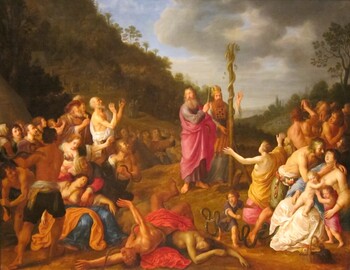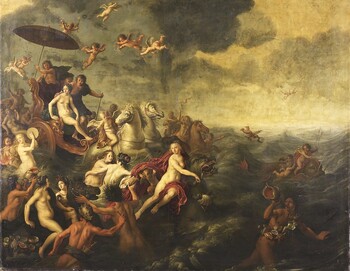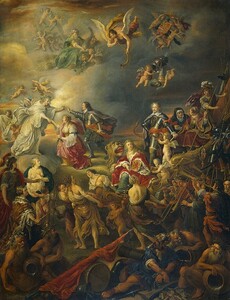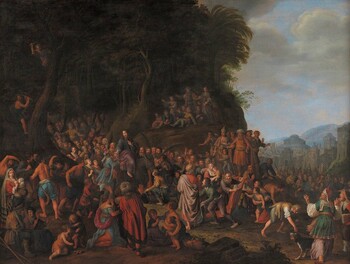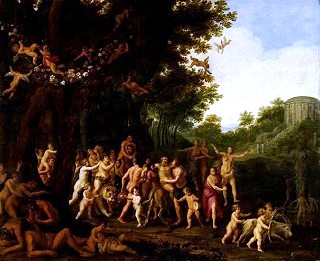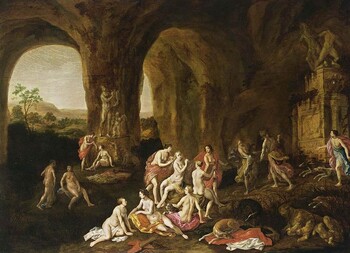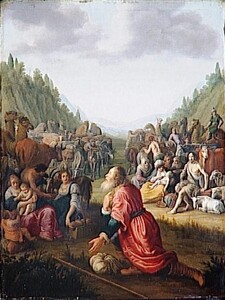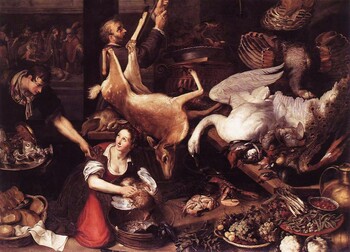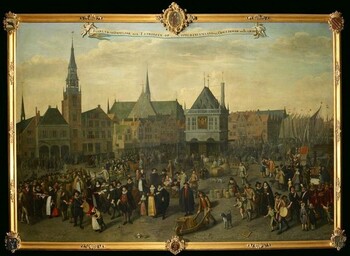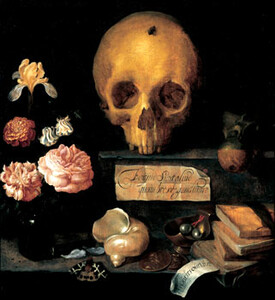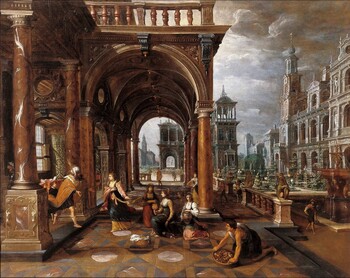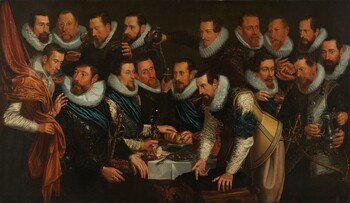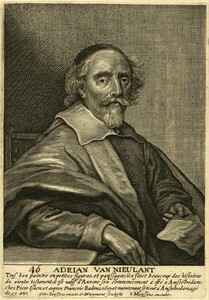23.000 €
The musical contest between Pan and Apollo
Oil on oval panel : 67,0 X 91,6 cm
Unsigned
Frame : 87,0 X 111,1 cm
In short
Adriaen van Nieulandt was a versatile Amsterdam painter, who painted very diverse subjects. Apparently at a young age he was already rich thanks to early investments in the Dutch East Indies Company.
Our painting represents the musical contest between the god of the woods, Pan, who was half-man half-goat and the sun god Apollo, whom Pan had challenged. Tmolus pronounced Apollo the winner, but right of him King Midas said Pan should have won. Apollo punished his stupid judgement by giving him ass’s ears. The women at left are the Nine Muses.
About Adriaen van Nieulandt
Dutch painter of Flemish origin
Antwerp 1587 – 1658 Amsterdam
He is sometimes referred to as Adriaen I, sometimes as Adriaen II. This is because his father, who was not an artist, but a pedlar and pen merchant, bore the same first name.
Pupil of Frans Boudens II (1571 – 1618) and of Pieter Isaacsz. (1568 -1625).
Versatile painter of very different subjects, such as landscapes, history subjects (religious and mythological), portraits and still lifes.
Brother of the painters Willem II (1584 – 1633/36) and Jacob (1592/93 – 1634). Their uncle, Willem I or Guilliam I (1560-1626) was the first painter of the family; he was active in Rome since 1596.
Following the conquest of Antwerp by Spanish, thus Catholic troops, our Adriaen’s father, the quill merchant, moved with his family to Amsterdam.
Adriaan van der Willigen and Fred Meijer (2003, P.150) date this move to Amsterdam already circa 1588, Jan De Maere (1994, P. 300) in 1607. In any case during those years numerous Flemish Protestants fled to Holland. Adriaen’s father died when our painter was only 17 years old. Our painter married already at the age of 22; the couple had 9 children.
Our Adriaen van Nieulandt spent the rest of his life in Amsterdam, except for a stay in Denmark in 1619, working for King Christian IV in the Castle of Frederiksborg (11 paintings on copper for the chapel). I should also mention that a single painting of Adriaen, dated 1612, is inscribed “Antwerpen”. Adriaen’s brother, Willem II, lived at that time in Antwerp since 1606.
Adriaen van Nieulandt was fascinated not only by different subjects, but also by different styles. At the start of his career he was influenced by Paulus Bril and Cornelis van Haarlem. Later, in Amsterdam, he studied under Pieter Isaacsz. and under Frans Badens.
Adriaen van Nieulandt is also known to have painted the figure staffage in landscapes by Frans Post and in five architectural scenes by Paul Vredeman de Vries, possibly also even by his father, Hans Vredeman de Vries.
He was also active as an art dealer, valuer of paintings and estate agent.
Adriaen van Nieulandt was already at a young age very rich; just as his Master Pieter Isaacsz. he belonged to a small group of 1.143 early shareholders in the Dutch Indies Company.
About the subject of our painting
Apollo, Greco-Roman god of the sun and of music, poetry and prophecy, was audaciously challenged to a musical duel by the minor, rural god of the woods, Pan, who is traditionally depicted half man – half goat.
The umpire, the old mountain god Tmolus, declares at the centre of our painting Apollo, who is playing his violin, the victor. But King Midas of Phrygia, richly attired and standing between Tmolus and Pan, disagrees with this decision and says that Pan, holding his panpipes, should be declared the winner. Furiously, Apollo has turned Midas’s ears into those of a donkey, as a sign of his foolishness.
The young women left of Apollo represent the nine Muses. Apollo was the leader of the Muses, who were goddess of literature, science and arts:
- Erato (Muse of love poetry and lyric poetry)
- Terpsichore (Muse of dance)
- Thalia (Muse of comedy and pastoral poetry)
- Urania (Muse of astronomy)
- Euterpe (Muse of flutes and music)
- Clio (Muse of history)
- Calliope (Muse of epic poetry)
- Polymnia (Muse of sacred poetry)
- Melpomene (Muse of tragedy)
At the right side van Nieulandt painted other Satyrs. Two of them are picking bunches of grapes, thus referring to Pan’s close relationship with Dionysos, god of wine, festivity and wild frenzy.
In the foreground a river god is resting against a large shell. A similar shell appears in the Vanitas still life in the Frans Hals Museum in Haarlem. The reclining river god must represent river Pactolus, which rises from Mount Tmolus (named after the umpire of the contest) in Lydia. In Antiquity the Pactolus was known for its sediments carrying gold and electrum, a natural ally of silver and gold, which actually had the colour of the huge shell. King Midas appears in another story of Ovid: Midas having entertained for ten days Dionysus’ old schoolmaster and foster father, the old Satyr Silenus, Dionysus offered him the choice of any reward. Midas asked that everything that he touched would change into gold. As his food and drinks also changed into gold he prayed to Dionysus for help, who told him to wash into river Pactolus, so that his power flowed into the river.
About the Dutch version of Ovid’s Metamorphoses.
The Greek myth of the musical contest between Apollo and Pan was written down in the “Metamorphoses” by the famous Roman poet Ovid (Publius Ovidius Naso, 43 BC – 18 AD), a compilation of 250 Classical Greek myths written in Latin verses. These were translated in Dutch and published in 1604 by Karel van Mander (1548 – 1606), a Flemish-born Dutch painter, writer and art theoretician. This translation was part of van Mander’s famous “Book of Painting” (“Schilder-Boeck”). That book was a compilation of three books: a translation of the “Lives” of Vasari, a similar collection of lives of Dutch, Flemish and German painters, and finally a translation of The Metamorphoses, that was followed by a guide explaining the figures. Van Mander died already two years after the publication of his “Schilder-Boeck”, which became very influential. In 1618 a second edition was published. His version of the Metamorphoses became so popular that it was sold as a separate book.
Why should you buy this painting?
Because it is a magnificent oval composition telling one of Ovid’s best-known stories.

